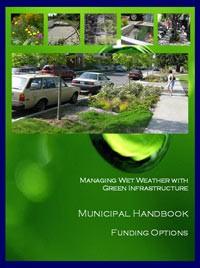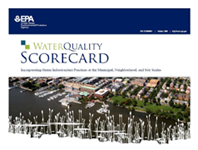Policy Guides
Site-scale green infrastructure practices provide important environmental, social, and economic benefits, but the water quality benefits of green infrastructure are most dramatic when green solutions are integrated throughout a watershed. The policy guides presented below can assist municipalities in growing green infrastructure throughout the built environment. As discussed below, collaboration among multiple departments and negotiation of multiple priorities are generally key.
On this page:
Municipal Handbook
 EPA's Municipal Handbook provides local governments with a step-by-step guide to growing green infrastructure in their communities. The handbook’s five editions discuss funding options, retrofit policies, green streets, rainwater harvesting policies, and incentive mechanisms. Each chapter provides a discussion of available programs and policies and several case studies.
EPA's Municipal Handbook provides local governments with a step-by-step guide to growing green infrastructure in their communities. The handbook’s five editions discuss funding options, retrofit policies, green streets, rainwater harvesting policies, and incentive mechanisms. Each chapter provides a discussion of available programs and policies and several case studies.
Funding Options – Effective stormwater programs require a reliable source of funding, and programs that support green infrastructure are no exception. Communities interested in moving beyond demonstration projects and integrating sustainable stormwater management into the built environment must identify appropriate sources of funding. This chapter discusses three of the options communities have identified - stormwater fees, loan programs, and grant programs.
Retrofit Policies – While new development represents an ideal opportunity for implementing green infrastructure, impaired waters cannot be restored without addressing stormwater from existing development. This chapter explores policies and incentives to restore water quality by retrofitting the existing built environment.
Green Streets – Green infrastructure in the public right of way can have a particularly high impact on water quality and community livability. This chapter assesses programs and policies developed to integrate green infrastructure into public roads and other transportation networks.
Rainwater Harvesting Policies - Rainwater harvesting can reduce stormwater runoff, conserve potable water, and provide environmental and economic benefits. This chapter discusses rainwater harvesting principles, designs, code requirements, and policies. Barriers to implementation are also addressed, and case studies from across the country demonstrate successful rainwater harvesting programs.
Incentive Mechanisms – Green infrastructure on private property can significantly reduce the public cost of stormwater management. This chapter describes a number of incentives that municipalities can offer to promote the implementation of green infrastructure on private properties and reduce their stormwater management costs.
More Policy Guides
Green infrastructure practices are most likely to protect water resources when integrated with the principles of Smart Growth. Smart Growth is an approach to development that seeks to accommodate population growth and create cohesive communities while conserving natural resources. EPA has produced a series of publications examining the relationships between Smart Growth and water resources protection.
Enhancing Sustainable Communities with Green Infrastucture - A guide to help communities better manage stormwater while achieving other environmental, social, and economic benefits
Green Infrastructure Case Studies: Municipal Policies for Managing Stormwater with Green Infrastructure (PDF) - (76 pp, 8.23 MB, About PDF)This report examines the policies adopted by 12 local governments that have successfully promoted green infrastructure, as well as the policy drivers and policy outcomes. A menu of policy options is presented and barriers and lessons learned are summarized.
Local Water Policy Innovation: A Road Map for Community Based Stormwater Solutions - This American Rivers report argues that local governments are in the best position to manage the water quality impacts of urbanization. The report describes 10 measures that local governments can take to minimize the degradation of water resources. Examples of cities that have implemented these measures are presented throughout the report.
Stormwater Solutions: Turning Oregon's Rain Back into a Resource (PDF)(68 pp, 1.9 MB, About PDF) Exit - Developed by the Oregon Environmental Council, this guide for local government officials, planners, and developers offers a set of recommendations to protect human health, natural resources and public infrastructure from the impacts of urban runoff.
Parking Spaces / Community Places: Finding the Balance through Smart Growth Solutions - Describes approaches that can help communities explore new, flexible parking policies that can encourage growth and balance parking needs with their other goals. The report also demonstrates the significance of parking decisions in development patterns and presents case studies of places that are successfully using these strategies.
Protecting Water Resources with Higher-Density Development - This 2006 EPA report assess the impact of development density on water resources. The findings indicate that low-density development may not always be the preferred strategy for protecting water resources.
Protecting Water Resources with Smart Growth - This 2004 EPA guide is intended for audiences committed to the principles of smart growth and interested in developing policies that simultaneously promote Smart Growth and protect water resources. Seventy five policies are suggested to effectively advance these complementary objectives.
Using Smart Growth Techniques as Stormwater Best Management Practices - This 2005 report reviews nine common Smart Growth techniques and examines how these techniques can be adapted to prevent or manage stormwater runoff.
Stormwater Guidelines for Green, Dense Redevelopment - Developed by Emeryville, California, this set of guidelines for developers and designers published in 2005 describes several strategies for managing stormwater on-site in a dense, redevelopment context.
More Policy Tools
 These communication and program evaluation tools are designed to help local governments effectively promote green infrastructure. By providing a framework for discussion among multiple agencies and measurement of progress to date, these tools can assist local governments in realizing their green infrastructure goals.
These communication and program evaluation tools are designed to help local governments effectively promote green infrastructure. By providing a framework for discussion among multiple agencies and measurement of progress to date, these tools can assist local governments in realizing their green infrastructure goals.
Water Quality Scorecard - This EPA product is a tool that communities can use to collaboratively identify the barriers to green infrastructure in local codes and ordinances. The scorecard guides municipal staff through 230 policies, codes, and incentives that could be adapted to promote sustainable stormwater management. The scorecard also provides extensive references and case studies.
Using Rainwater to Grow Livable Communities Exit- This toolbox created by the Water Environment Research Foundation provides resources for effective communication and implementation of green infrastructure concepts, as well as case studies that examine successful efforts in cities across the United States.

